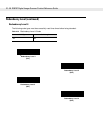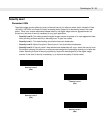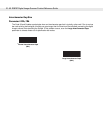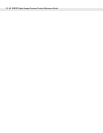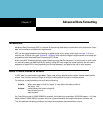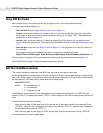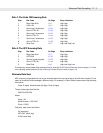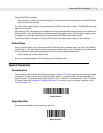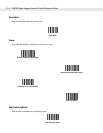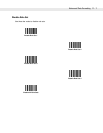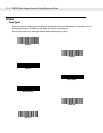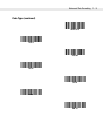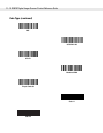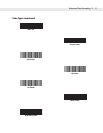
11 - 4 DS6707 Digital Imager Scanner Product Reference Guide
But, when there is a sale, send only the following:
24 (class key)
56712437 (stock key)
and the cashier will key the price manually.
To implement this, first enter an ADF rule that applies to the normal situation, such as:
Scan Rule Belongs to Set 1. When scanning a bar code of length 15, send the next 2 characters, send the
class key, send the next 8 characters, send the stock key, send the data that remains, send the Enter key.
The “sale” rule may look like this:
Scan Rule Belongs to Set 2. When scanning a bar code of length 15, send the next 2 characters, send the
class key, send the next 8 characters, send the stock key.
To switch between the two sets of rules, a “switching rule” must be programmed. This rule specifies what type
of bar code must be scanned to switch between the rule sets. For example, in the case of the “sale” rule above,
the rule programmer wants the cashier to scan the bar code “M” before a sale. To do this, a rule can be entered
as follows:
When scanning a bar code of length 1 that begins with “M”, select rule set number 1.
Another rule could be programmed to switch back.
When scanning a bar code of length 1 that begins with “N”, turn off rule set number 1.
The switching back to normal rules can also be done in the “sale” rule. For example, the rule may look like this:
When scanning a bar code of length 15, send the next 2 characters, send the class key, send the next 8
characters, send the stock key, turn off rule set 1.
For optimal results, scan the Disable All Rule Sets bar code on page 11-7 after programming a rule belonging
to an alternate rule set.
In addition to enabling and disabling rule sets within the rules, enable or disable them by scanning the
appropriate bar codes on 11-7.
Rules Hierarchy (in Bar Codes)
The order of programming individual rules is important.The most general rule should be programmed first.
All programmed rules are stored in a buffer. As they are programmed, they are stored at the “top” of a rules list.
If three rules have been created, the list would be configured as follows:
Third Rule
Second Rule
First Rule
When data is scanned, the rules list is checked from top to bottom to determine if the criteria matches (and
therefore, if the actions should occur). Input is modified into the data format specified by the first matching set
of criteria it finds. Be sure to program the most general rule last.
For example, if the THIRD rule states:
When scanning a bar code of any length, send all data, then send the ENTER key.



